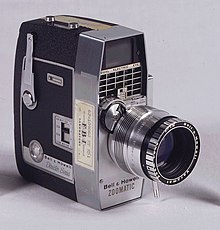Zapruder movie
The so-called Zapruder film is a film shot by the amateur filmmaker Abraham Zapruder , on which the assassination attempt on John F. Kennedy on November 22, 1963 can be seen.
background

Zapruder captured the scene on Kodak Kodachrome color film in normal 8 format without sound recording. A 414 PD Zoomatic film camera from the Bell & Howell Director Series with 18.3 frames per second was used. The device was quite advanced for the time when many amateur filmmakers were still working in black and white. The entire film sequence was filmed from an elevation (concrete platform) on Dealey Plaza and comprises 26.6 seconds, of which 19.3 seconds show the actual assassination attempt. The sequence consists of a total of 486 individual images.
Zapruder, a textile entrepreneur, was assisted by his secretary Marilyn Sitzman during the recording. From his position, Kennedy's motorcade, approaching on Elm Street, was almost exactly in front of and below him at the time of the assassination. Of all the film recordings made at Dealey Plaza, the film is the one on which the events can be seen most clearly, on the one hand because of the high-quality camera technology, on the other hand because the camera is located in a relatively close proximity to Kennedy's open car.
The film was used as important evidence by the Warren Commission and the later investigative commissions set up to investigate the attack. The Warren Commission published 13 images in Volume XVIII, which make up less than a second of the entire film. Copies of the film were widely distributed in the media and are still freely accessible on the Internet, among other places.
Some conspiracy theorists have suggested that the film has been manipulated. However, Kodak specialist Roland Zavada who examined the film said no changes had been made to it. There are also several other film recordings that show details in the immediate vicinity of the assassination that coincide with those that can be seen on the Zapruder film. These recordings were made by F. Mark Bell, Charles L. Bronson, Robert JE Hughes, John Martin, Charles Mentesana, Patsy Paschall, Elsie Dorman, Tina Towner, Marie Muchmore and Orville Nix, as well as an unidentified woman. The shots themselves can be seen in the footage of Nix, Muchmore and Bronson, while Bronson and Hughes also show the open window from which Lee Harvey Oswald , according to the Warren report, fired the shots.
Further use of the film
On the afternoon of November 22, 1963, three copies of the film were made for investigation purposes. The Life magazine purchased the stock and associated rights for $ 150,000. Part of the contract was that the actual effect of the shot on Kennedy's head would not be seen (Fig. 313). Zapruder paid the first $ 25,000 installment to the widow of policeman JD Tippit, who was shot by Oswald shortly after the Kennedy assassination .
Life editor Will Lang Jr. then arranged for large-format prints of individual images both for the corresponding report in Life magazine and for the Warren Commission. As a result, Life repeatedly presented individual images from the film, but the editorial staff otherwise largely kept the original film under lock and key and not shown it publicly. As in the movie JFK - Tatort Dallas from Oliver Stone to see made Jim Garrison , a lawyer from New Orleans in the trial of Clay Shaw , the environment in a conspiracy in the Kennedy assassination had been accused of participation, that the Zapruder- The 1969 film was shown at the Shaw trial. In this context, further copies of the film were made, which soon found their way into the public. A first film screening in front of a mass audience took place in 1975 as part of the late-night TV show Good Night America , whereupon the US House of Representatives created a new commission of inquiry (Church committee) into the Kennedy assassination (which again, like the Warren Commission , Declared Oswald to be a shooter). In 1975, Life returned the original film for $ 1 to the Zapruder heirs (Abraham Zapruder died in 1970), who in turn made it available to the US government to avoid any possible deterioration in the quality of the aging film. The film was then transferred to the US National Film Library in College Park, Maryland. The whereabouts of the original film and some copies were traced in the 1988 documentary Image of an Assassination: A New Look at the Zapruder Film . In 1998 the US government formally took possession of the original film, with the Zapruder family being reimbursed $ 16 million in return, which, however, also waived all rights to the film. In 1994 the film was also included in the US National Film Registry as a document of cultural historical significance .
literature
- Sibylle Machat: The murder of the century. Assassination in front of the camera , in: Gerhard Paul (Hrsg.): The century of pictures. 1949 to today , Vandenhoeck and Ruprecht, Göttingen 2008, pp. 282–289 ISBN 978-3-525-30012-1
- David R. Wrone: The Zapruder Film. Reframing JFK's Assassination , University Press of Kansas, 2003, ISBN 0-7006-1291-2
- Luis W. Alvarez: A physicist examines the Kennedy assassination film. At the. J. Physics 44 (1976) no. 9, pp. 813-827
Web links
- Zapruder film in the Internet Movie Database (English)
- Compilation of the 486 individual images
- The story of the Zapruder film
- JFK Kennedy shooting, Zapruder audio video . Creative Commons Attribution License.